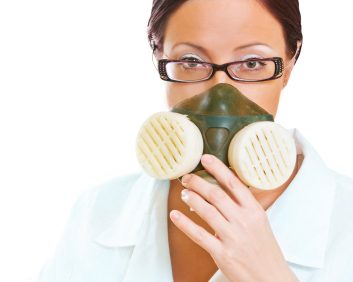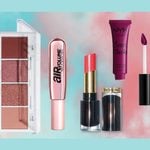The truth about fragrance sensitivity
In this era of scrutiny of cosmetic ingredients, fragrance-free products are part of the buzz. What is it about scent that makes some people so sensitive?

Source: Best Health Magazine, March/April 2009
Fragrance isn’t for everyone. It makes some people cough, wheeze, sneeze, break out in an itchy rash or clutch their head in a migraine attack. So while many of us love scent, some prefer to be able to choose cosmetic products without it.
In fact, 37 percent of Canadian women look for cosmetics or skincare products that are free of fragrance, according to a poll by Roper Reports Canada, which conducts face-to-face interview surveys for businesses, including personal-care companies.
‘I like to wear a little bit of fragrance, but these days I am very careful of what I put on so that I don’t bother others,’ says Holly Nathan, a communications officer at the University of Northern British Columbia, adding that wearing scents ‘seems to be more socially unacceptable’ these days.
Is fragrance sensitivity for real?
For those sensitive to fragrance, it’s not ‘just in their heads.’ Fragrance in personal-care products is the second most common cause of allergic skin reaction (after nickel in jewellery) and the most common cause
of reactions from personal-care products, according to Dr. Sandy Skotnicki-Grant. She is medical director of the Bay Dermatology Centre in Toronto and a leading Canadian expert on contact dermatitis (an inflammation that can cause redness, dry skin and blisters). A study in 2004 found that 11 percent of people had a reaction when patch-tested with a standard mix of fragrances used in cosmetics and grooming products.
Common ingredients that can cause a reaction are citronella, oak moss, balsam of Peru and synthetic fragrances (particularly Lyral). And, increasingly, we’re seeing reactions to botanical fragrances such as ylang ylang, jasmine and narcissus, Skotnicki-Grant says.
‘Just because it’s a natural fragrance doesn’t mean it won’t have an irritant or allergic effect,’ she says. ‘A lot more companies today are using fragrances that come from botanical sources. We are starting to see reactions to things like sage and thyme that we don’t use in our standard patch of the most common allergens. So our impression is that reactions to fragrance certainly have increased.’
Dr. Roy Fox, medical director of the Nova Scotia Environmental Health Centre (Canada’s leading centre for people who suffer from environmental sensitivities), notes that surveys show about 16 percent of the population now reports sensitivity to environmental triggers such as strong odours, and about five percent of people report the symptoms are severe enough that they are made physically ill.
Each year, more than 300 new patients are referred to Fox’s clinic, most of them because they have started to react to environmental triggers, especially fragrances. The majority are in their 30s and 40s. About half of these patients have worked in jobs with a high level of exposure to chemicals’and strong smells’for example, painters, hairdressers, pest exterminators and autobody workers.
‘It’s as if the human body, after living a lifetime of exposure, can no longer deal with it,’ Fox says. Common symptoms are headache, coughing, muscle aches, breathing difficulties, confusion and fatigue. And, he notes, a new study found that 44 percent of people who suffer from migraines say strong fragrances can bring on an attack.
Fox says a fascinating series of studies out of Sweden has shown that some sensitive individuals react even when wearing a sealed mask and breathing fresh air. When a fragrance was released into the room without the subjects’ knowledge, the mask meant they couldn’t smell it or breathe it into their lungs, but still they began to show symptoms. The researchers concluded the fragrance may be triggering symptoms upon exposure to patients’ eyes or skin.
The rise of fragrance-free products
Fortunately, there seems to be more choice. A quick perusal of drug- and department stores indicates a larger selection of personal-care products with little scent, or specifically labelled unscented or fragrance-free, than even a year ago. One of the new trends in cosmetics, for instance, is fragrance-free mineral makeup. Just a few of the many skincare lines with fragrance-free options include Aveeno, Olay, Kiss My Face and Curel, in addition to long-standing fragrance-free companies Marcelle and Clinique. Spectro also has a long history of fragrance-free skin care.
The online brand Paula’s Choice is fragrance-free. For hair care, La Coupe recently came out with a fragrance-free line. Darren Praznik, president of the Canadian Cosmetic, Toiletry and Fragrance Association, notes that the cosmetics industry is highly competitive and keenly sensitive to consumer demand and customer need. ‘We have been seeing a greater interest in scent-free and fragrance-free products, so consequently the industry has been very responsive and will continue to be responsive to that consumer demand.’
Wearing fragrance in public
One thing is certain: In the last five years, scent-awareness policies have increasingly been posted in public spaces, and it is not uncommon now to see ‘Please, no scent’ signs in many Canadian hospitals, universities, libraries, doctors’ and dentists’ offices and workplaces.
For those who do enjoy fragrance in their lives, and who think scent banning is taking things too far, Holly Pattison, administrator of the Environmental Law Centre at the University of Victoria, has one solution. She often feels guilty wearing perfume so, she says, ‘I save it for special occasions and use it sparingly.’
To wear scent responsibly, a rule of thumb is that the fragrance should be somewhat private. It should stay within your personal ‘scent circle’: About an arm’s-length away from your body is the farthest anyone should be able to detect it.
Label lingo: ‘Fragrance-free’ vs. ‘unscented’
‘Fragrance-free,’ according to international and Canadian labelling laws, means that no fragrance or perfumes have been added during the manufacturing process.
‘Unscented’ means the product may contain a compound classified as a fragrance by the International Nomenclature of Cosmetic Ingredients (INCI; a standardized list established by the European Commission in 1996) and used as a masking agent. Essentially, it prevents the nose from smelling the unpleasant odour of the other ingredients.
If you react to fragrances, choose fragrance-free products (those without perfume or parfum in the ingredient list), since products labelled unscented may still provoke a reaction, notes Toronto dermatologist Dr. Sandy Skotnicki-Grant.
As for words on the label such as ‘hypo-allergenic’ or ‘for sensitive skin,’ those terms have no established legal or scientific meaning under INCI or national labelling laws, says Skotnicki-Grant. ‘They are just marketing terms and people may still have reactions.’
Halifax leads the way in North America
The most scent-aware region in North America is Halifax, where over the last 10 years the Regional Municipality of Halifax, the provincial government, many businesses, the transportation systems, many performances spaces, hospitals and educational institutions have adopted a scent-awareness policy. Although non-enforceable, it is a code of conduct requesting that people be aware of others’ sensitivities and forgo scents.
Elsewhere in Canada, universities with scent-awareness policies include the University of Calgary, University of Toronto and McMaster University.
Should fragrances be banned in public spaces? Tell us what you think in our forums.
This article was originally titled "Fragrance Sensitivity," in the March/April 2009 issue of Best Health. Subscribe today to get the full Best Health experience’and never miss an issue!’and make sure to check out what’s new in the latest issue of Best Health.




